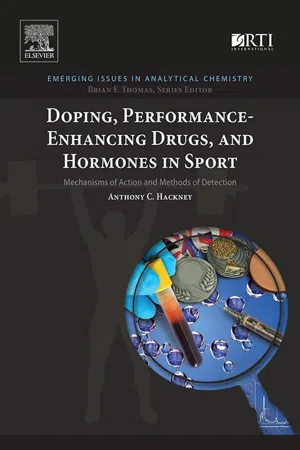
Doping, Performance-Enhancing Drugs, and Hormones in Sport
Mechanisms of Action and Methods of Detection
- 168 pages
- English
- ePUB (mobile friendly)
- Available on iOS & Android
Doping, Performance-Enhancing Drugs, and Hormones in Sport
Mechanisms of Action and Methods of Detection
About This Book
Doping, Performance-Enhancing Drugs, and Hormones in Sport: Mechanisms of Action and Methods of Detection examines the biochemistry and bioanalytical aspects of performance-enhancing drugs (PEDs) and other questionable procedures used by athletes to enhance performance. The book informs the specialist of emerging knowledge and techniques and allows the non-specialist to grasp the underlying science and current practice of the discipline.
With clear and compelling language appropriate for a broad spectrum of readers, this book provides background on prevalence, types of agents, their actual or supposed benefits, and their negative effects on health. The technical aspects of detection are discussed, followed by a discussion of why detection is a problematic and still-evolving science. To facilitate comprehension, each chapter is organized in a uniform way with six sections: (1) standard medical uses, (2) why the drugs are used by athletes, (3) biological mechanism of action, (4) what research says about efficacy in improving performance, (5) major health side effects from use and abuse in sport, and 6) concluding key points.
- Presents the scientific concepts of how performance enhancers work, how they are used, and how they are detected and masked from detection
- Features language that is neither simplistic to scientists nor too sophisticated for a large, diverse global audience
- Provides a short "close-up" in each chapter to illustrate key topics that engage, entertain, and create a novel synthesis of thought
Frequently asked questions
Information
Overview
Doping in Sport
Abstract
Keywords
History and Current State of the Problem
Table of contents
- Cover image
- Title page
- Table of Contents
- Copyright
- Dedication
- List of Contributors
- Foreword
- Preface
- Acknowledgments
- Chapter 1. Overview: Doping in Sport
- Chapter 2. Anabolic Androgenic Steroids
- Chapter 3. Stimulants
- Chapter 4. Glucocorticoids
- Chapter 5. Peptide–Protein Hormones
- Chapter 6. Beta-2 Agonists
- Chapter 7. Hormone and Metabolic Modulators
- Chapter 8. Narcotics
- Chapter 9. Beta Blockers
- Chapter 10. Athlete Testing, Analytical Procedures, and Adverse Analytical Findings
- Chapter 11. The Future of Performance Enhancement in Sport
- Index